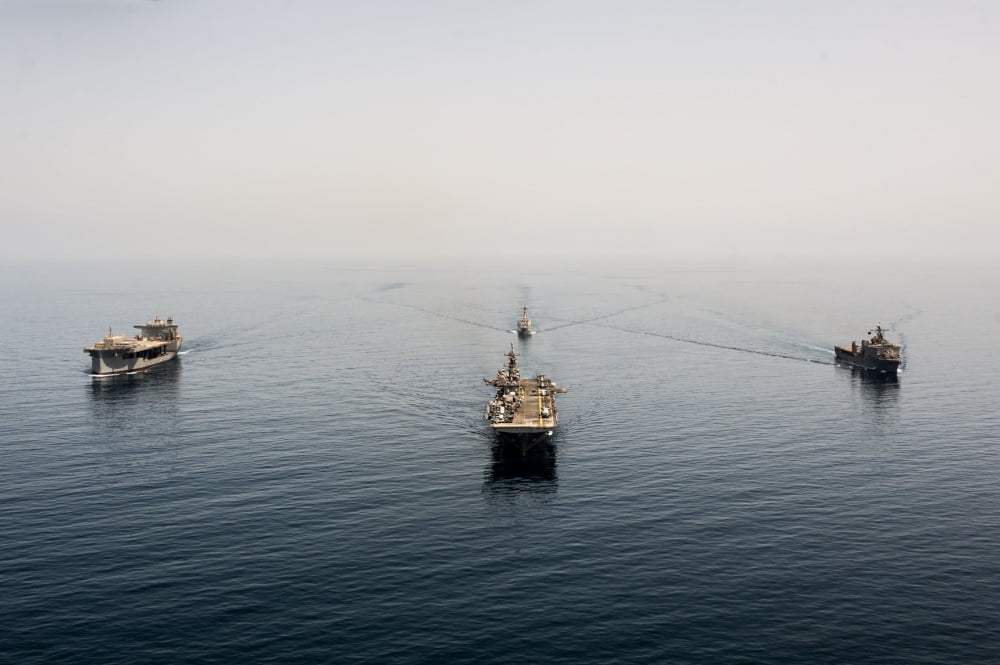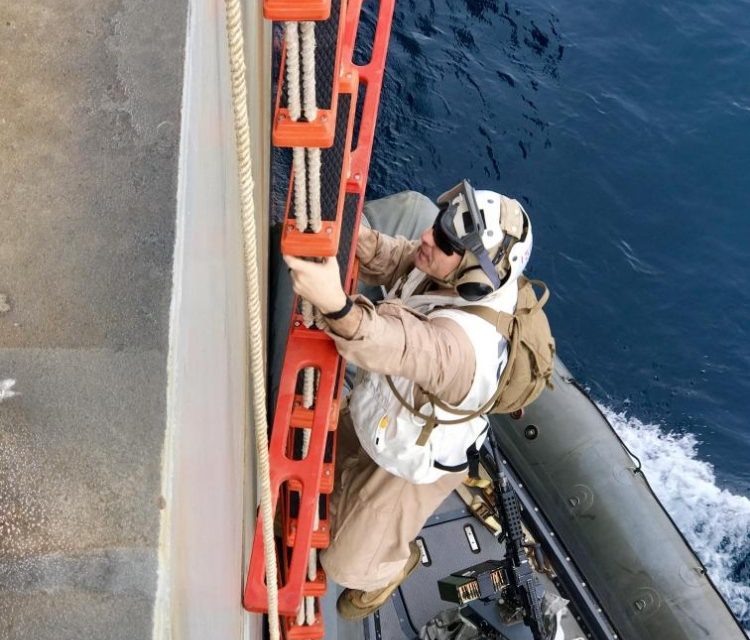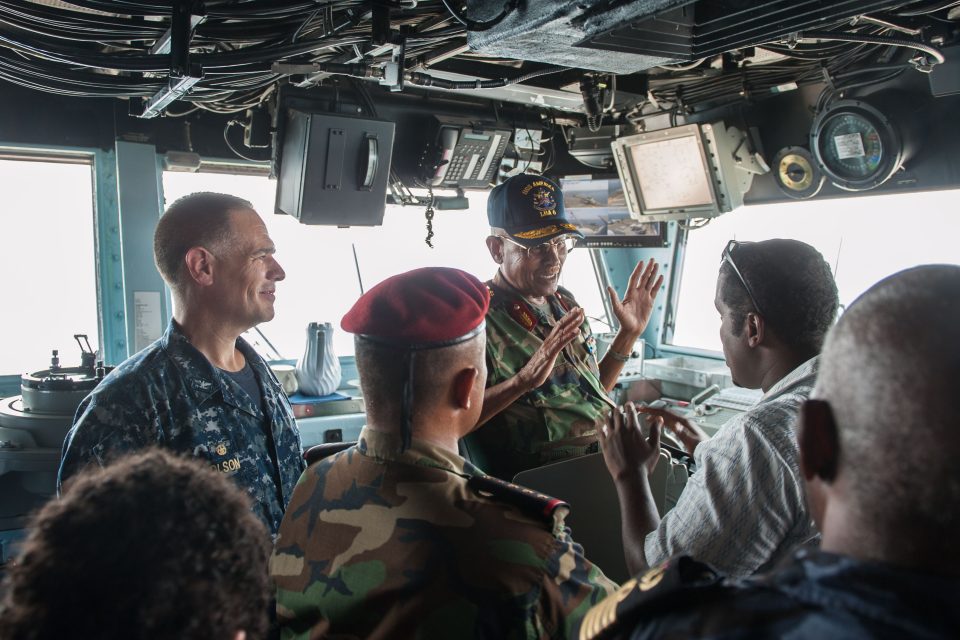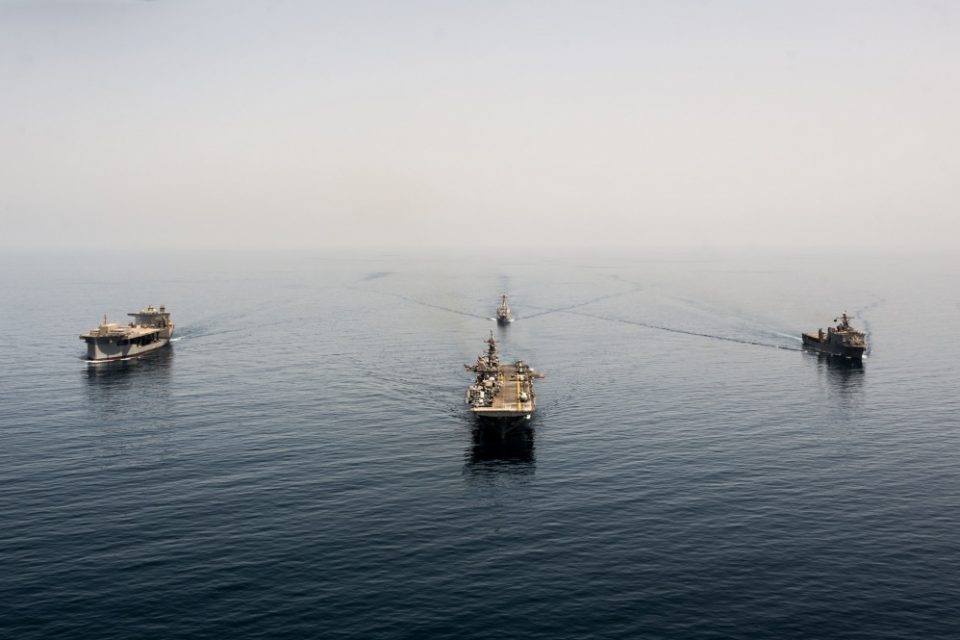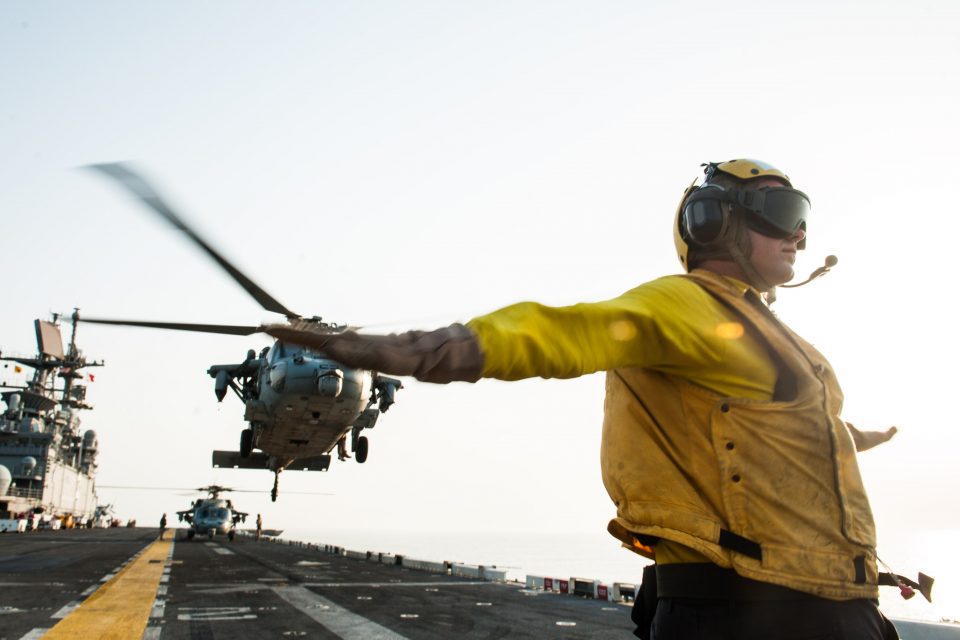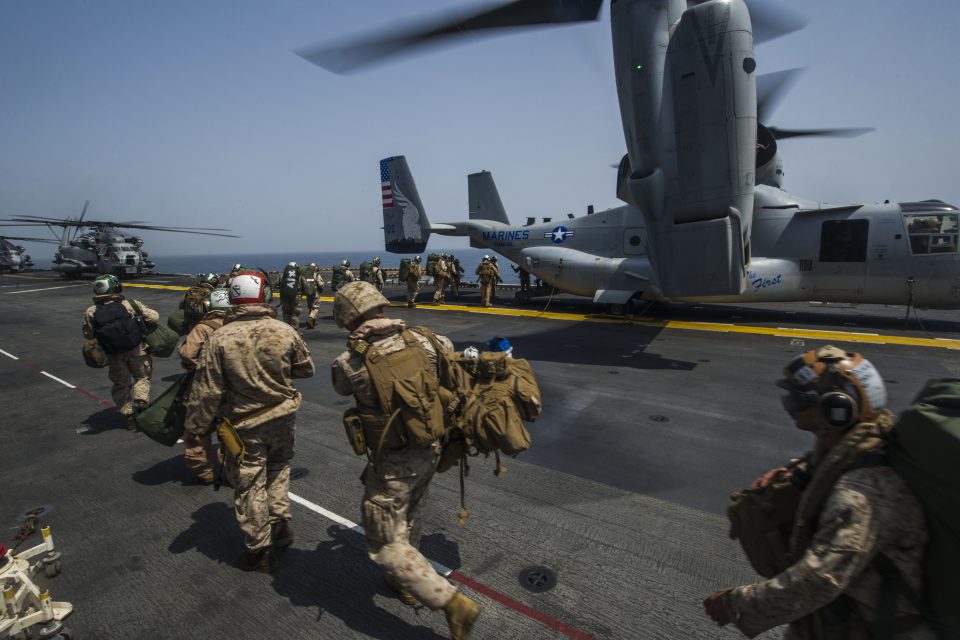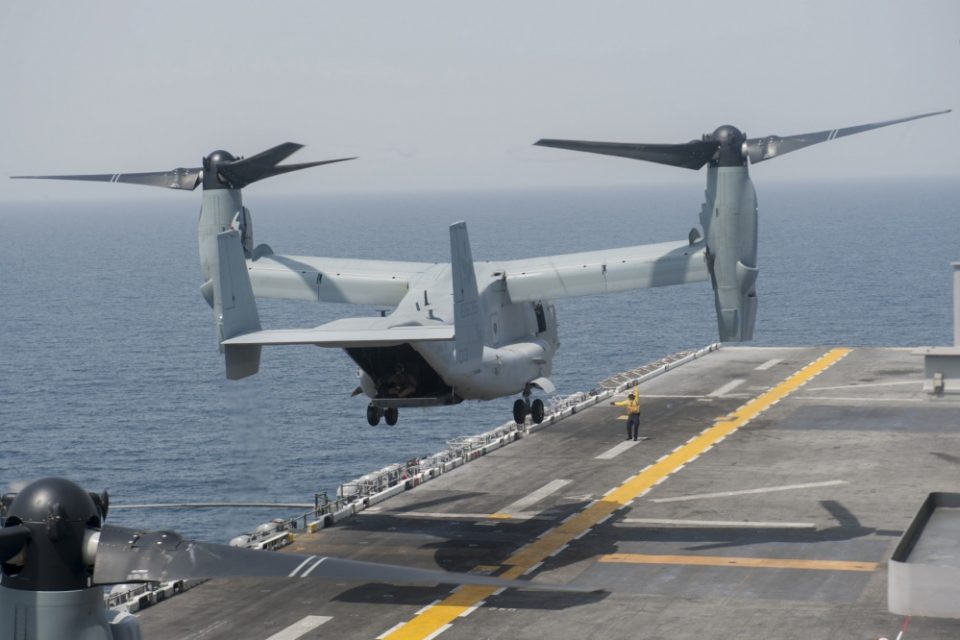2017-09-22 The USS America is the new kid on the block in terms of amphibious warfare.
It has been joined in the Alligator Dagger by another new kid on the block as well, the aviation modified support ship, the USNS Puller.
USS Lewis B. Puller (ESB-3), (formerly USNS Lewis B. Puller (T-ESB-3)), (formerly T-MLP-3/T-AFSB-1) is the first purpose-built Expeditionary Mobile Base (previously Mobile Landing Platform, then Afloat Forward Staging Base) vessel for the United States Navy.
It’s one of two Expeditionary Sea Base (ESB) variants of the U.S. Navy’s planned fleet of Expeditionary Transfer Dock vessels.
We have visited both ships during their construction period and have highlighted their contributions to the evolving amphibious task force which the USN-Marine Corps team are crafting for 21st century operations.
According to an article by MC2 Alexander Ventura II, USS America Public Affairs, the USS America has recently completed Alligator Dagger 2017.
GULF OF ADEN – Marines and Sailors aboard the amphibious assault ship USS America (LHA 6) with the embarked 15th Marine Expeditionary Unit (MEU) and Amphibious Squadron (PHIBRON) 3 rehearsed amphibious operations and combat sustainment in the vicinity of Djibouti during Alligator Dagger 2017 Sept. 4-20.
Alligator Dagger is a dedicated, unilateral combat rehearsal led by Naval Amphibious Forces, Task Force 51/5th Marine Expeditionary Brigade, in which combined Navy and Marine Corps units of the America Amphibious Ready Group (ARG) and embarked 15th MEU were able to train and employ integrated capabilities available to U.S. Central Command both afloat and ashore.
The exercise also involved the amphibious dock landing ship USS Pearl Harbor (LSD 52) and amphibious transport dock ship USS San Diego (LPD 22) of the America ARG, along with the expeditionary support base ship USS Lewis B. Puller (ESB 3), the newly commissioned afloat forward staying base variant of the mobile landing platforms.
As additional support, the ARG also utilized the Arleigh Burke-class guided-missile destroyers USS Howard (DDG 83) and USS Kidd (DDG 100). Training with a wide range of ship types and classes during Alligator Dagger allowed the ARG to refine their maritime capabilities and preparing them for tactical requirements and future operations.
“As we entered the 5th Fleet area of operations we were well aware that we had to acclimate as an ARG/MEU team to both the environment in terms of weather and the threat,” said Capt. Rome Ruiz, commander, PHIBRON 3.
“We have a wide range of capabilities between our ships, aircraft, logistical equipment and personnel, which enables our blue-green team to handle multiple missions at one time.
Alligator Dagger has been a valuable opportunity for the ARG/MEU team to not only rehearse for new and ongoing operations but to also demonstrate our combat proficiency and flexible combat potential in support of crisis response and regional stability.”
The rehearsal focused on amphibious assaults; helicopter-borne raids; visit, board, search and seizure operations; air strikes; defense of the amphibious task force; integrated ground-and-air fires; tactical recovery of personnel; ground reconnaissance; medical casualty evacuations; combat marksmanship and quick reaction force and casualty evacuation rehearsals.
“We have trained extensively to enhance our methods and responses to possible scenarios that we may see,” said Capt. Joseph Olson, America’s commanding officer.
“I’m very proud of the team work throughout this training evolution. I’m confident that through the crew’s grit, tactical knowledge and competence, we’ll be ready to meet whatever challenges lie ahead.”
The 15th MEU consists of the command element; aviation combat element, Marine Medium Tiltrotor Squadron (VMM) 161 (Reinforced); the ground combat element, 1st Battalion, 5th Marines; and the logistics combat element, Combat Logistics Battalion 15.
While in the region, the southern California-based Navy-Marine Corps team falls under CTF 51/5, and will help ensure the free flow of commerce, provide crisis response and support ongoing missions in the 5th Fleet area of operations.
The role of the USS Puller was the focus of attention in a story published on 9/21/17 provided by the US Navy:
U.S. 5TH FLEET AREA OF OPERATIONS – Sailors and Marines aboard the expeditionary sea base USS Lewis B. Puller (ESB 3) and Marines assigned to the 15th Marine expeditionary unit (MEU) and Fleet Anti-terrorist Security Team Central Command completed combat rehearsals for Alligator Dagger 2017, Sept. 16.
Alligator Dagger, led by Naval Amphibious Forces, Task Force 51/5th Marine Expeditionary Expedition Brigade, is a dedicated, unilateral combat rehearsal that combined Navy and Marine Corps units of the America Amphibious Ready Group and embarked 15th MEU to practice, rehearse and exercise integrated capabilities available to U.S. Central Command both afloat and ashore.
The exercise also tested USS Puller’s maritime capabilities for crisis response and contingency operations within U.S. 5th Fleet.
“We deployed with the ability to embark other forces including the mine hunting unit, which allows us to sweep a safe path to the beach for the amphibious forces,” said Lt Cmdr. Douglas Ivey, the Puller’s combat system’s officer. “Since then we’ve been used as a support vessel for various aviation assets, acted as a target vessel for visit, board, search and seizure exercises and provided the mine hunting boats for surface exercises.”
Commissioned Aug. 17, Puller is the first U.S. ship to be commissioned outside of the United States and the first of the expeditionary sea base variant. Due to its versatility and range of capabilities, the ship continues to be assessed for use in a variety of potential mission areas.
“A lot of what we’re doing in Alligator Dagger 2017 is learning what this ship can do,” said Ivey. “This is a new platform. It was originally designed for aviation mine counter measures and special operation forces support, but now that we’re using it in an operational environment, we realized that USS Puller has the potential to support operations in a lot of different ways. ”
The ship also demonstrated its ability to support training for the 15th MEU’s Low Altitude Air Defense Detachment (LAAD), further strengthening its blue-green team integration.
“While we were onboard we had the opportunity to conduct live fire gun shoots, weapons training with Puller Sailors as well as establish training plans for defense from low altitude air threats for the ship,” said Capt. Thomas Rees, officer in charge, LAAD. “Any time we have a chance to train our personnel on a different platform or environment it improves their ability to defend no matter what the surroundings.”
Expeditionary base USS Lewis B. Puller (ESB 3) is forward-deployed to the U.S. 5th Fleet area of operations to extend U.S. Naval Forces Central Command’s maritime reach in 5th Fleet by supporting a wide variety of missions including counter-piracy operations, maritime security operations, humanitarian aid, disaster relief and crisis response operations.
U.S. 5th Fleet area of operations encompasses about 2.5 million square miles of water area and includes the Arabian Gulf, Gulf of Oman, Red Sea and parts of the Indian Ocean. The expanse comprises 20 countries and includes three critical choke points at the Strait of Hormuz, the Suez Canal and the Strait of Bab al Mandeb at the southern tip of Yemen.
https://www.dvidshub.net/news/249062/uss-puller-participates-alligator-dagger
And in an article written by Captain Maida Zheng, 15th Marine Expeditinary Unit, and published on 9/21/17 , the role of the 15th MEU was the focus of attention.
DJIBOUTI (Sept. 21, 2017) – The 15th Marine Expeditionary Unit (MEU) and the America Amphibious Ready Group (ARG) concluded Exercise Alligator Dagger, the largest regional amphibious combat rehearsal, Sept. 20.
Alligator Dagger is designed to integrate and synchronize capabilities that are available to U.S. Central Command (CENTCOM) both afloat and ashore to ensure forces are postured and prepared to execute operations at sea, from the sea, and ashore.
The 15th MEU has been the first to fight, both from the sea and ashore. The MEU spearheaded Operation Restore Hope in Somalia in 1992, launched the longest amphibious-heliborne assault in history into Afghanistan in October 2001 and established Camp Rhino, and boarded German-owned hijacked Motor Vessel (M/V) Magellan Star in 2010 to swiftly regain control of the vessel, detaining nine Somali pirates.
“Our distinct ability to gain access to critical areas anywhere in the world with ground, air and logistics forces enables us to counter the actions of non-state actors who may threaten the security and stability of the region,” said Col. Joseph Clearfield, the 15th MEU commanding officer.
“The dangers we are seeing in the 5th Fleet area of responsibility are extremist ideologies that have complete disregard for humanity and pose a serious terrorist threat to this region and to our homeland. We are looking forward to working ‘by, with, and through’ partner forces to militarily defeat violent extremist organizations in the area of responsibility,” Clearfield added.
Alligator Dagger provided an unparalleled opportunity for the ARG and MEU to practice critical mission sets that enhance capabilities inherent to the Navy-Marine Corps team. Marines and Sailors rehearsed various water and land-based exercises, ranging from live-fire events and explosive ordnance disposal missions conducted on ranges in the vicinity of Arta Beach, to visit, board, search and seizure (VBSS) operations on static and motor platforms off the coast of Djibouti.
The 15th MEU’s Force Reconnaissance Detachment completed two VBSS full-mission profiles, practicing the same mission set the Marines conducted for MV Magellan Star. First, the Helicopter Assault Force fast-roped via an MH-60S Sea Hawk onto USS LEWIS B. PULLER (ESB 3), an expeditionary sea base designed to provide dedicated support for air mine countermeasures and special warfare missions around the globe.
The Reconnaissance Marines quickly descended and searched the vessel, detaining any hostile individuals in the process. The next day, the Boat Assault Force moved into position via rigid hull inflatable boats (RHIBs) and latched a ladder onto the side of the ship to begin their assault.
“During both operations, the Sea Hawk served as an aerial sniper over-watch and close air support (CAS) platform as the Marines took control of the vessel,” explained U.S. Navy Lt. Laura Starck, the MH-60S Sea Hawk pilot who flew during the mission. “This is a typical integration piece for us and proves our capabilities as a multi-mission platform.”
Marine Medium Tiltrotor Squadron 161 (Reinforced) recertified several CH-53E Super Stallion and MV-22B Osprey pilots for night systems qualifications in high-light level and low-light level, as well as AH-1Z Cobra and UH-1Y Huey pilots in close air support during Alligator Dagger. These qualifications enable the Aviation Combat Element (ACE) to provide the six functions of Marine Aviation to the Marine Air Ground Task Force (MAGTF).
“The ACE’s Marine Air Traffic Control Mobile Team provided air traffic control functions while training with Djiboutian tower personnel, enabling safe air operations in the area as well as developing working relationships with the host nation airfield,” explained Maj. Bjorn Thoreen, the operations officer for VMM-161.
AV-8Bs, RQ-21As and H-1s conducted CAS and tactical recovery of aircraft and personnel (TRAP) mission rehearsals while MV-22s and CH-53s conducted forward arming and refueling point (FARP), TRAP and casualty evacuation training. The ACE externally lifted a 21,600 pound aircraft tow tractor from USS America (LHA 6) to USS Pearl Harbor (LSD 52), which helped enable the LSD to become an air capable ship.
“Having the LSD as an air capable ship enables the MAGTF commander to have another afloat forward staging base option in the area if desired to conduct operations from,” explained Thoreen.
The training achieved by the ACE during Alligator Dagger was critical to prepare for expeditionary operations in the CENTCOM area of operations.
Throughout the course of Alligator Dagger, the Battalion Landing Team (BLT) 1st Battalion, 5th Marines focused its training on core infantry skills.
“The austere environment presented a unique opportunity to rehearse infantry actions and employ weapon systems in support of maneuver in the world’s roughest terrain and in an environment most of our Marines are not accustomed to operating in,” said Maj. Joseph Fontanetta, the BLT operations officer. “We employed all organic weapon systems and conducted supported live-fire attacks up to the squad level, sustaining skills for possible real-world employment,” he explained.
The BLT’s motorized units, made up of the Combined Anti-Armor Team and Light Armored Reconnaissance, conducted static gunnery for all crew-served weapons systems as well as fire and maneuver up to the section level.
The BLT also conducted a fire support coordination exercise that included all of the BLT’s Fire Support Teams as well as artillery, mortars and integration with the MEU’s Air Naval Gun Liaison Company, the ARG’s MH-60 detachment, Hueys, Cobras and Harriers with the ACE. The BLT practiced combined arms employment to support maneuver, conducting basic call for fire, immediate suppression, illumination, and suppression of enemy air defense missions.
“By integrating the above elements to support the maneuver of ground forces, we were able to demonstrate our ability to bring all elements of the MAGTF to bear on enemy forces,” said Fontanetta.
The Logistics Combat Element (LCE) provided combat logistics support and sustainment for all elements ashore throughout the execution of Alligator Dagger. Support ranged from food and water resupply to the execution of convoy operations that helped sustain forces ashore.
Engineers produced more than 46,000 gallons of water over a period of eight days. The Landing Support Detachment established a Landing Force Support Party executing 77 hours of operations during a 10 day period — serving as a central hub for entry and exit of equipment and personnel for the America ARG.
“This training enabled the LCE to conduct expeditionary operations providing combat logistics support from the sea and facilitate the operational tempo and reach of the battalion landing team to operate deeper into the Arta battle space without delaying or degrading training opportunities,” said Maj. George Steinfels, the Combat Logistics Battalion 15 operations officer. “The CLB provides a unique advantage which enables this MAGTF to sustain operations afloat and ashore for extended periods.”
Within 48 hours of arriving ashore, the LCE commenced water production and the establishment of a beach support area/combat logistics support area that provided a command and control hub for all elements arriving ashore.
The LCE quickly and effectively transitioned inland, conducting more than 40 combat logistics patrols for over 120 hours of convoy operations, transporting an impressive 25,400 gallons of water, 590 gallons of fuel, 7,800 meals, approximately 3,500 kilograms of ice and 18 pallets of ammunition, supporting more than 400 personnel movements covering a total of 3,870 miles of road.
The LCE’s ability to sustain the MEU during Alligator Dagger demonstrated its ability to sustain the MEU in real world operations – demonstrating the expeditionary prowess of the amphibious force.
“The ARG/MEU’s ability to rapidly maneuver integrated Navy and Marine Corps forces from across the U.S. Central Command’s area of responsibility to provide immediate response options is key to ensuring command and control of forces at sea, from the sea, and ashore,” said Brig. Gen. Frank Donovan, commander of Naval Amphibious Forces, Task Force 51/5th Marine Expeditionary Brigade.
“Alligator Dagger is a critical combat rehearsal that ensures our Sailors and Marines are fully capable of conducting operations across the full spectrum of conventional, unconventional and hybrid warfare. After seeing the ARG/MEU complete a series of complex rehearsals in austere conditions, I’m confident that they are postured and prepared to execute any crisis response mission within the AOR at a moment’s notice.”
Serving as the nation’s premier crisis response force, the 15th MEU and America ARG are forward deployed and poised to rapidly respond to crises in the 5th Fleet area of responsibility.
https://www.dvidshub.net/news/249092/15th-meu-america-arg-complete-combat-rehearsal-alligator-dagger
The photos in the two slideshows are credited to the USN-Marine Corps team.
The first slideshow highlights flight ops on the USNS Puller; the second are shots from the overall exercise,


